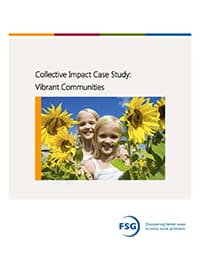Paul Born, president, and Liz Weaver, vice president of the Tamarack Institute discuss reducing poverty using a collective impact approach.
Vibrant Communities is a multi-layer collective impact initiative focused on unleashing the potential of communities across Canada to reduce poverty and ensure a good quality of life for all citizens. This case study provides collective impact backbone organizations, funders, and partners with an overview of the initiative and key lessons learned.
Top Takeaways
- Navigate power dynamics to incorporate perspectives of people with lived experience: Tamarack has been deliberate about inviting people with lived experience to join leadership roundtables, but has found that power dynamics often stifle the impact of their contributions. Tamarack has amplified the voices of those with lived experiences through a variety of techniques, such as focus groups and other structures, giving them the opportunity and agency to help shape the initiatives intended to benefit them.
- Incentivize funder involvement in the initiative: Tamarack maintains a practice of involving funders in the initiative beyond their direct financial contribution by encouraging participation in initiative convenings and organizing a community of practice where funders can share knowledge and develop expertise. Tamarack has found that funder participation increases knowledge and trust, which in turn leads to greater commitment through challenges.
- Experiment with developmental evaluation: Finding that traditional forms of evaluation do not suffice to measure and improve complex community change, Tamarack has embraced experiments with developmental evaluation. Real-time processing of information and “sense-making” of the feedback that distinguishes developmental evaluation from other forms of evaluation and has made it a particularly successful tool for Vibrant Communities to learn about and improve their approach to poverty reduction.

